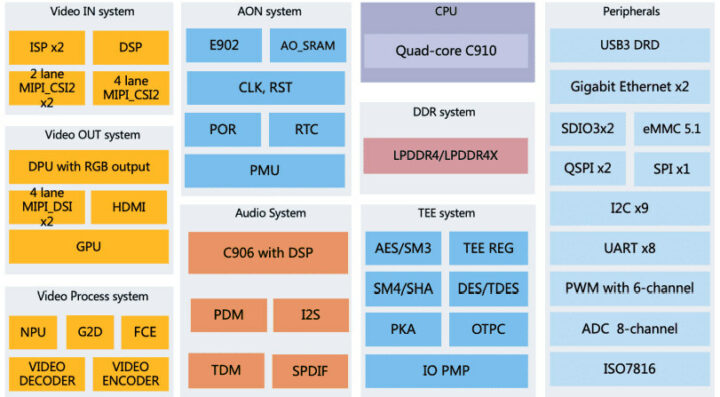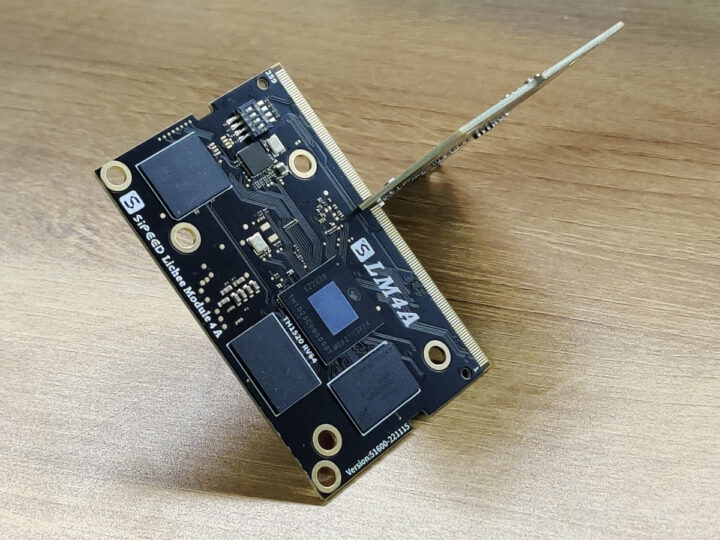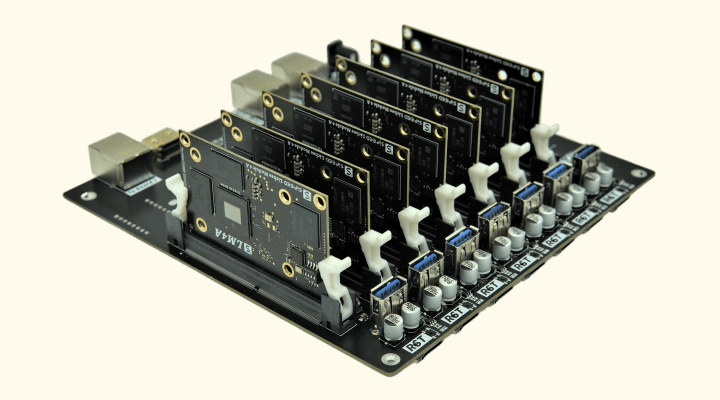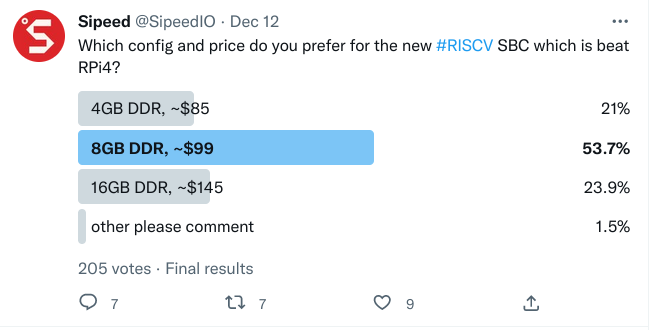Sipeed LM4A is a quad-core RISC-V system-on-module based on the T-Head TH1520 SoC found in the ROMA laptop and destinated to be found in a Raspberry Pi SBC competitor as well as a cluster board.
The LM4A, which stands for Lichee Module 4 Model A, comes with 4GB to 16GB RAM, and up to 64GB flash, and connects to the carrier board through a 260-pin SO-DIMM connector. The TH1520 is one of the rare RISC-V SoCs with a 3D GPU, and the SBC based on LM4A has been shown to outperform the Raspberry Pi 4 in benchmarks as we’ll see below.
Sipeed LM4A specifications:
- SoC – Alibaba T-Head TH1520 quad-core RISC-V Xuantie C910 (RV64GCV) processor @ 2.5 GHz, Xuantie C906 audio DSP @ 800 MHz, low power Xuantie E902 core, 50 GFLOPS Imagination 3D GPU, and 4 TOPS NPU
- System Memory – 4GB, 8GB, or 16GB RAM
- Storage – Optional eMMC flash with 16GB, 32GB, or 64 GB capacity
- Networking – Up to 2x Gigabit Ethernet PHY
- Host interface – 260-pin SO-DIMM connector
- Dimensions – 69 x 45mm

We do not have the full specifications at this time, but the company also shared some benchmarks showing the CPU performance of the upcoming LPi4A SBC @ 1.85 GHz against the Raspberry Pi 2/3/4, and a StarFive JH7110 board, likely the VisionFive 2.
I’m sure some will say the Dhrystone benchmark is outdated and susceptible to compiler flags, and those are true statements, but Dhrystone and CoreMark are the only results we have here for now. The LPi4A’s C910 core is shown to have similar performance or even higher than the Raspberry Pi 4’s Cortex-A72 core. The RISC-V board was only running at 1.85 GHz, so performance should scale if the processor can indeed be clocked at the advertised 2.5 GHz. Both the RV64GC toolchain and an optimized toolchain was used in CoreMark, but it’s unclear what the optimized toolchain does. There may be more details in the Yocto Linux BSP for TH1520 hosted on Gitee.
I could not find a photo of the LPi4A SBC, but Sipeed shared a photo of a cluster board with seven LM4A RISC-V system-on-module each with a USB 3.0 port, and I can see what looks like a few RJ45 ports on the back as well as on one HDMI output.
Sipeed says the LM4A TH1520 system-on-module will be available in Q1 2023. There’s no price announcement but the company put up a Twitter poll about pricing and specs for a Raspberry Pi competitor with a RISC-V SBC, so we should not be surprised if the LPi4A SBC launches with 8GB RAM for $99…
There’s limited public information at this time, but you can follow the development progress on Twitter or Weixin.

Jean-Luc started CNX Software in 2010 as a part-time endeavor, before quitting his job as a software engineering manager, and starting to write daily news, and reviews full time later in 2011.
Support CNX Software! Donate via cryptocurrencies, become a Patron on Patreon, or purchase goods on Amazon or Aliexpress








